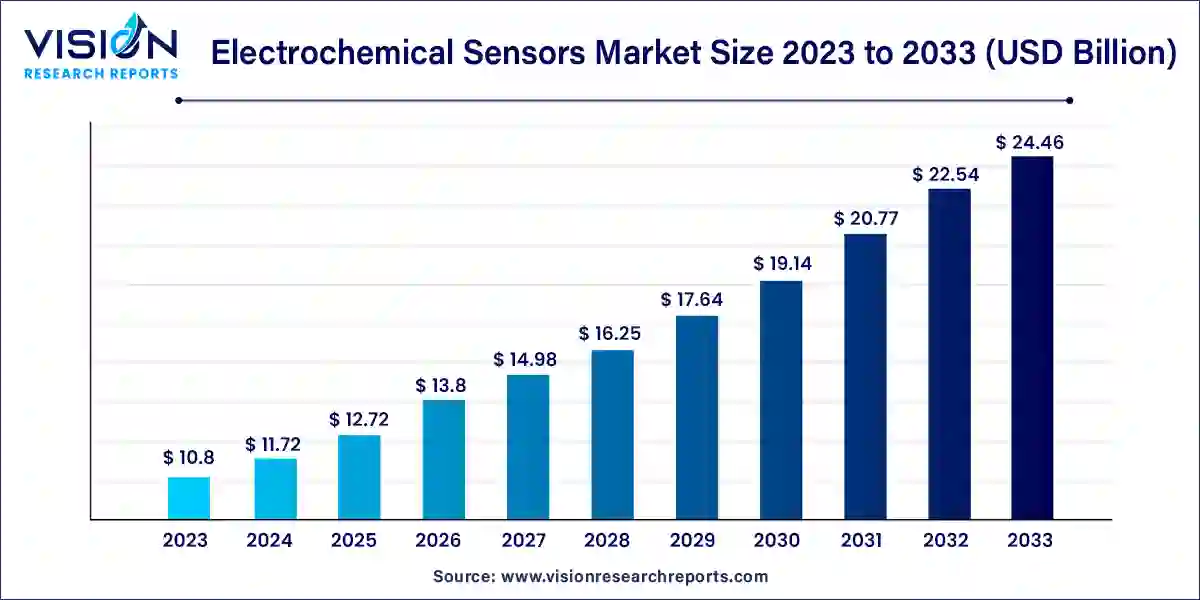The global electrochemical sensors market size was estimated at around USD 10.8 billion in 2023 and it is projected to hit around USD 24.46 billion by 2033, growing at a CAGR of 8.52% from 2024 to 2033. The electrochemical sensors market is a rapidly growing sector within the broader sensor technology industry. These sensors are crucial for measuring various chemical properties in a range of applications, including environmental monitoring, healthcare, food safety, and industrial processes. Electrochemical sensors work by detecting changes in the electric current or voltage produced by chemical reactions, making them essential tools for real-time monitoring and analysis.

The growth of the electrochemical sensors market is primarily fueled by an increasing focus on environmental protection has led to a heightened demand for monitoring air and water quality, where electrochemical sensors play a crucial role in detecting pollutants and ensuring compliance with regulatory standards. Additionally, the healthcare sector's ongoing shift towards personalized medicine is driving the need for reliable diagnostic tools, such as glucose meters and biosensors, that utilize electrochemical technology for real-time health monitoring. Technological advancements, including miniaturization and the integration of wireless communication, are enhancing sensor capabilities and broadening their application scope. Furthermore, rising industrial automation and the need for precise quality control in manufacturing processes are also contributing to market growth.
In 2023, the North American electrochemical sensors market led the industry, accounting for 41% of the total revenue share. This growth can be attributed to the increasing prevalence of chronic diseases, particularly diabetes, along with rapid technological advancements. Innovations such as miniaturized diagnostic devices that deliver quick and accurate results, alongside the rising adoption of Electronic Medical Records (EMR), are expected to propel market growth throughout the forecast period. Moreover, regulatory frameworks like the Clean Air Act, Clean Water Act, and the National Environmental Policy Act in the U.S., which facilitate ongoing monitoring of environmental pollution, are likely to create lucrative growth opportunities in the coming years.

The U.S. electrochemical sensors market commanded a revenue share of 85.35% in 2023. Currently, approximately 133 million Americans are believed to have at least one chronic condition, such as arthritis, heart disease, or hypertension. The increasing incidence of diabetes is a significant driver of market growth in the U.S.
In 2023, Europe held the second-largest revenue share in the electrochemical sensors market. The rising demand for healthcare sensors, coupled with supportive central data management systems aimed at delivering accurate information and medical services to patients, is expected to fuel market growth. The aging population in Europe and the growing emphasis on personalized medicine necessitate the development of rapid and user-friendly diagnostic tools beyond traditional laboratory environments.
The Asia Pacific electrochemical sensors market is anticipated to register the fastest compound annual growth rate (CAGR) of 9.9% during the forecast period. Factors driving this growth include a significant target population, increasing government initiatives, a rising incidence of food allergies, and substantial investments in research and development.
The electrochemical sensors market in Latin America is poised for substantial growth throughout the forecast period. Reforms in the healthcare system, an increasing number of countries pursuing universal healthcare coverage, and enhancements in healthcare infrastructure are key factors expected to drive market expansion in this region. Additionally, the rising prevalence of heart diseases is contributing to a growing number of diabetes patients, further bolstering market growth.
The healthcare segment of electrochemical sensors dominated the market in 2023, capturing a revenue share of 98%. The extensive use of biosensors in this sector significantly contributes to its growth. Advancements in nanomaterials and biomolecular techniques aimed at enhancing sensitivity have led to the development of sophisticated electrochemical biosensors. These sensors are utilized in various analytical, medical diagnostic, and screening applications due to their excellent performance, portability, simplicity, and affordability. Key healthcare applications for electrochemical sensors include cholesterol testing, blood glucose monitoring, and blood gas analysis, among others.
A major factor propelling the growth of blood glucose monitoring biosensors is the rising prevalence of diabetes. Effective blood glucose monitoring is essential for managing diabetes, and numerous advanced glucose biosensors have been introduced to assist patients in maintaining normal glucose levels. Blood Glucose Monitoring (BGM) represents the most successful application of electrochemical biosensor technology, leading to significant advancements in biosensor biology, chemistry, measurement techniques, and production processes. The integration of optimized enzymes, mediators, and electrochemical measurement methods is driving substantial improvements in BGM.
By Application
By Region
 Cross-segment Market Size and Analysis for
Mentioned Segments
Cross-segment Market Size and Analysis for
Mentioned Segments
 Additional Company Profiles (Upto 5 With No Cost)
Additional Company Profiles (Upto 5 With No Cost)
 Additional Countries (Apart From Mentioned Countries)
Additional Countries (Apart From Mentioned Countries)
 Country/Region-specific Report
Country/Region-specific Report
 Go To Market Strategy
Go To Market Strategy
 Region Specific Market Dynamics
Region Specific Market Dynamics Region Level Market Share
Region Level Market Share Import Export Analysis
Import Export Analysis Production Analysis
Production Analysis Others
Others